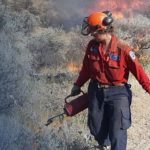Home »

Rocky Mountain Trench reveals forest project at AGM
By Erin Knutson
The Rocky Mountain Trench Natural Resources Society (RMTNRS) hosted a field tour Tuesday, June 4 to showcase its fuel reduction work on the Cranbrook Community Forest Project as part of its AGM. It was attended by natural resource managers and RMTNRS directors.

“It’s great to have everyone here and to see the effects of the project—it’s really important to demonstrate the benefits of fuel reduction in forests and to help reduce risk to the community,” said Coordinator for the Rocky Mountain Trench Natural Resources Society Marc Trudeau of mitigating hazardous fires and Ecosystem Restoration (ER).
Randy Harris (Former Team Leader for Ecosystem Restoration for the Rocky Mountain Trench) and retired Trench Society Executive Director Dan Murphy led professionals through a visual comparison of the benefits of thinning hectares to promote healthy forests in the East Kootenay.
“It was a huge fire hazard, and we finally found the money to do the thinning. This is immediately after harvest, and we haven’t had a growing season, now you have grass so there’s a lot more forage for animals and there’s a lot more shrub for wildlife,” said Harris.
The tour demonstrated positive effects of fuel reduction (thinning parts of the forest floor) to increase biodiversity in the area.
 The project was first proposed in 2008 to the City of Cranbrook and was executed in 2017. A total of 18.2 hectares of thinning on Crown land and 17.6 hectares on College of the Rockies property was undertaken and completed.
The project was first proposed in 2008 to the City of Cranbrook and was executed in 2017. A total of 18.2 hectares of thinning on Crown land and 17.6 hectares on College of the Rockies property was undertaken and completed.
From the hectares that were removed, 2,358,280 kilograms of green weight including 1,134 m3 of sawlogs and 2,062 m3 of pulpwood was recovered from the site.
 “The trees have too many small stems, and they are not growing well, and if you keep them too crowded they won’t grow,” said Harris. “Dendrochronology studies demonstrate a decline in tree growth from the 1940s with zero growth from the 1980s.”
“The trees have too many small stems, and they are not growing well, and if you keep them too crowded they won’t grow,” said Harris. “Dendrochronology studies demonstrate a decline in tree growth from the 1940s with zero growth from the 1980s.”
Historically, the project site which consists of a mesic Douglas fir forest (IDFdm2), contained 48 trees per hectare (Ponderosa Pine and Western Larch).

The trees were approximately 50 to 70 centimetres in diameter featuring a covering of high-value grasses, as opposed to the current 3,500 stems per hectare of Douglas fir ranging from five to 20 cm in diameter, characterized by a light moss-covered forest floor.
The effect of the growth has created sickly or vampire-like forests, which was evident in parts of the tour.
Excessive forest ingrowth is a result of dry forest types in the East Kootenay, according to research agrologist Tim Ross presented to guests in “The Long-Term Effect of Ecosystem Restoration Treatments on Understory Vegetation in the Ponderosa Pine Zone, prior to the tour.
“Fire suppression and insufficient stand-tending activities (forest treatments) have resulted in a serious forest ingrowth problem in these dry forest types which include the Rocky Mountain Trench and adjoining side-valleys, between the U.S. border and the Golden area. There are approximately 250,000 hectares of land in the Ponderosa Pine (PP) and the Interior Douglas-fir (IDF) bio-geoclimatic zones,” said Ross’ report.
According to Ross’ findings, a fire would return to these sites every five to 50 years, which is not the case today, creating a need to “rehabilitate over-stocked forests.”
The rehabilitation of over-stocked forests is a costly endeavour and one that needs attention.
“It costs millions to put out a fire, the money is there, but ecosystem restoration (ER) works on habitat for wildlife, and it would be nice to keep money for ER to do what has been done traditionally instead of using it for interface work,” said President of the Windermere Rod and Gun Club, Rick Hoar.
Lead image: Randy Harris demonstrates the effects of sickly forests on tree growth during a tour of the Cranbrook Community Forest Project at the Rocky Mountain Trench Natural Resources Society AGM on Tuesday, June 4. Photos by Erin Knutson

e-KNOW







